At the terminal for the public transportation boats in the capital of Martinique, Fort-de-France, I bought the ticket to a cove called L’Anse à l’Âne. I must have been a seafarer in one of my previous lives, since I always rejoice at an opportunity to take boats and this short trip was a great thing for me.
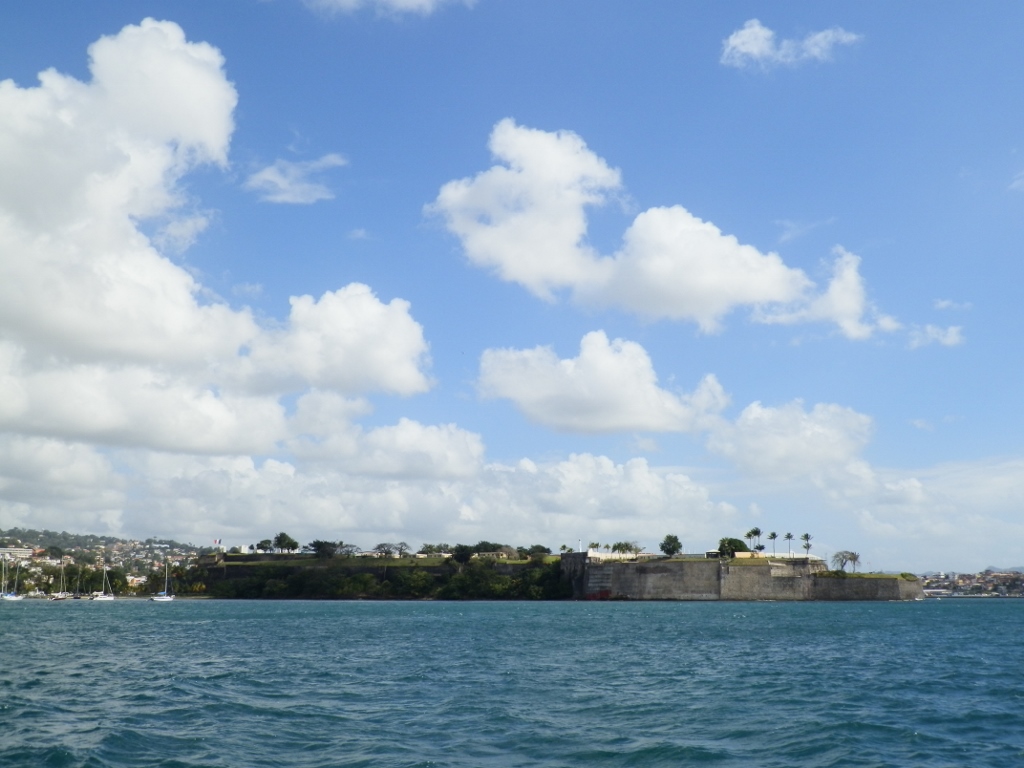 Fort Saint Louis fortress in the capital of Martinique, Fort-de-France, as seen from the sea
Fort Saint Louis fortress in the capital of Martinique, Fort-de-France, as seen from the sea
Fort Saint Louis is situated at a long promontory that separates a wide cove at which there is the old urban centre of Fort-de-France and a narrow but deep bay used for the docking of cruisers that I have already commented on in the previous sequel of my travel stories from Martinique.
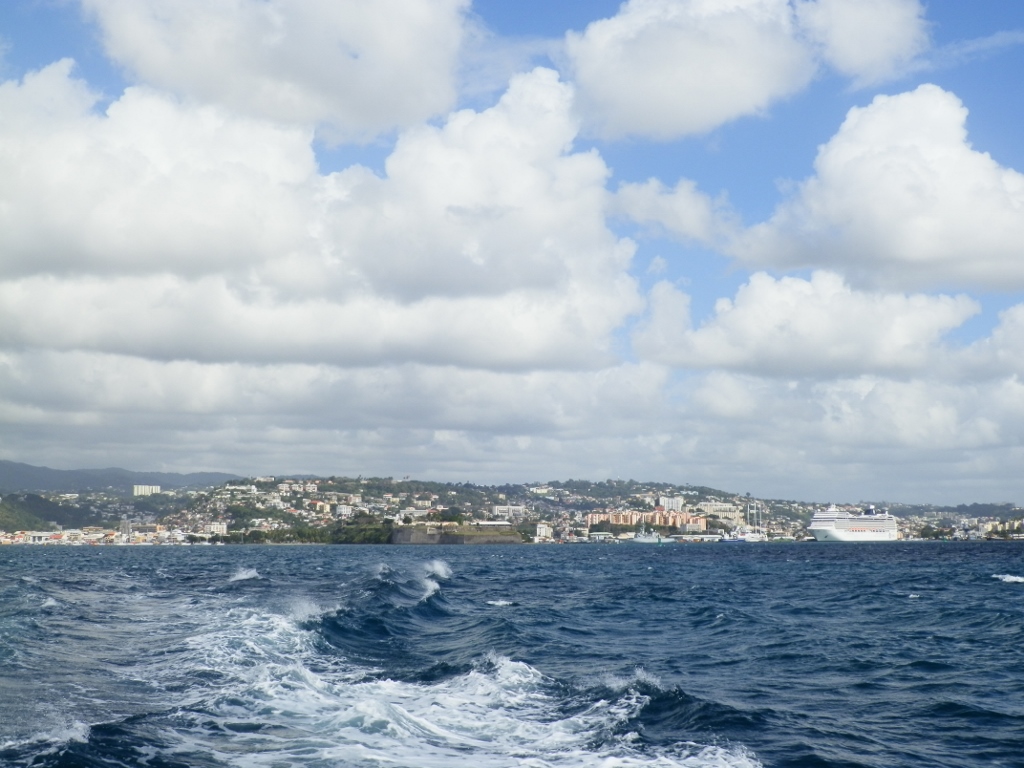 Fort Saint Louis roughly in the middle of the photo, while a typical cruiser is on the right
Fort Saint Louis roughly in the middle of the photo, while a typical cruiser is on the right
The line of the boat I was taking practically cut through the large Fort-de-France Bay that has several coves on the other side, as well as a larger tourist centre with a myriad of hotels and residences, and obviously restaurants, cafés and everything else that goes with tourism.
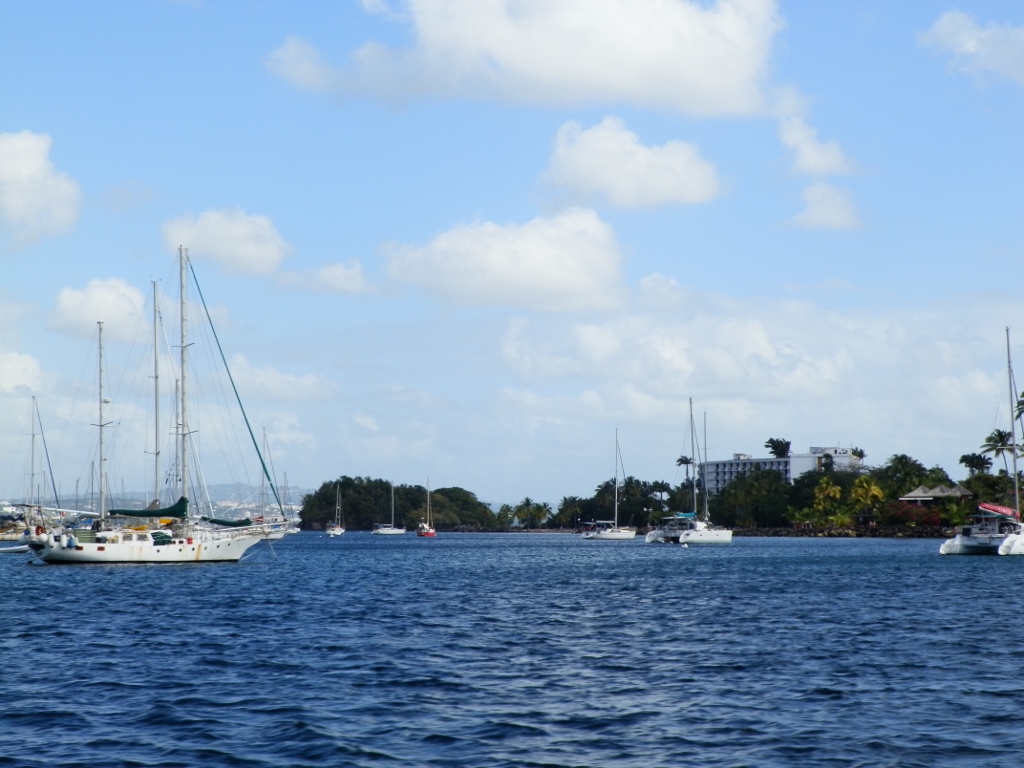 View at the horn across Fort-de-France with numerous tourist facilities
View at the horn across Fort-de-France with numerous tourist facilities
The boat first stopped at a cove called Anse Mitan where some of the passengers disembarked, while the rest of us continued to the next cove and this was also my destination for the day – Anse a l’Âne.
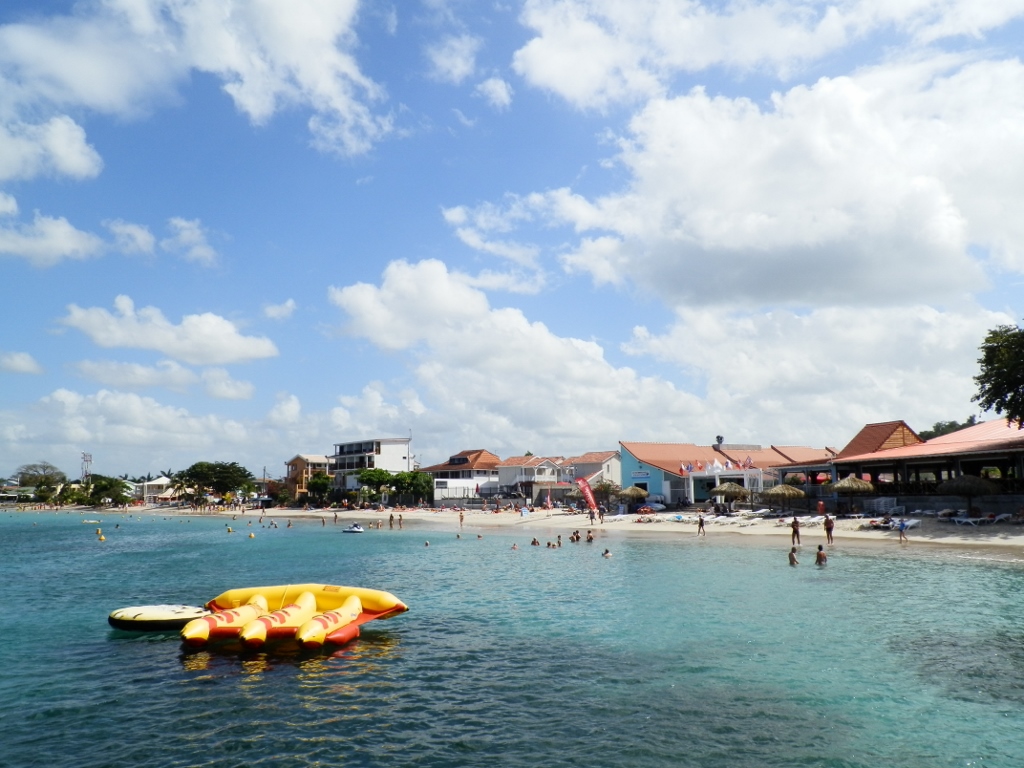 View from the boat at Anse Mitan
View from the boat at Anse Mitan
Anse a l’Âne is a somewhat deeper cove in comparison to Anse Mitan and it also differs in terms of the hillocks it is surrounded with that are covered in numerous residential and lodging houses.
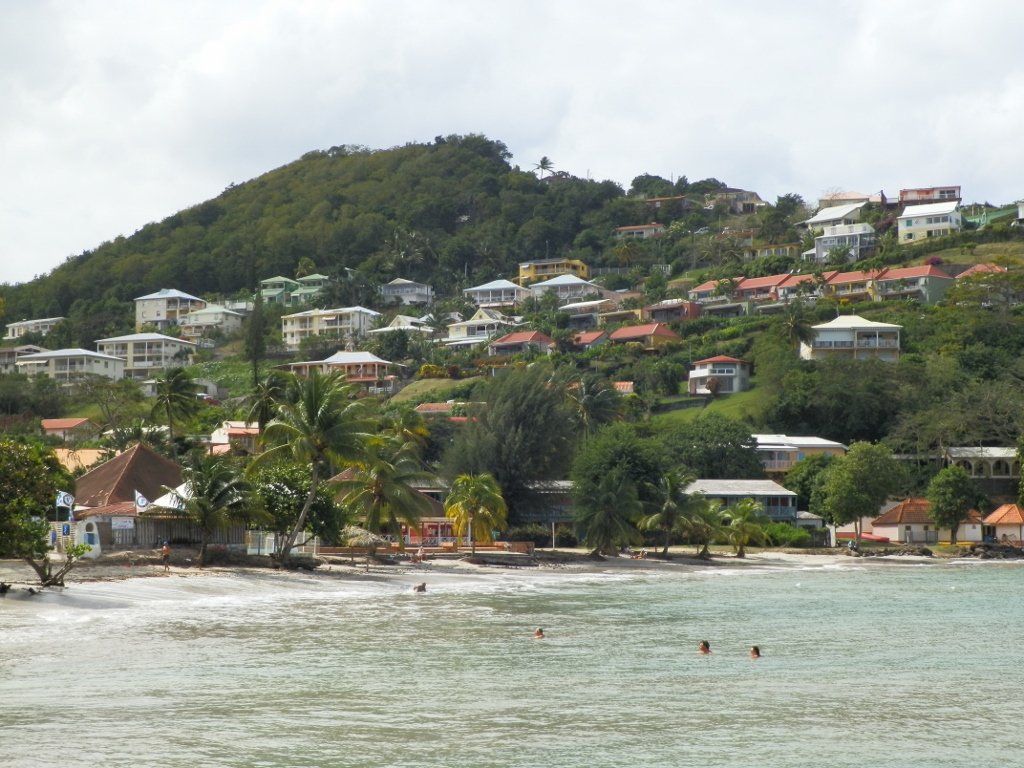 View from the boat at Anse a l’Âne
View from the boat at Anse a l’Âne
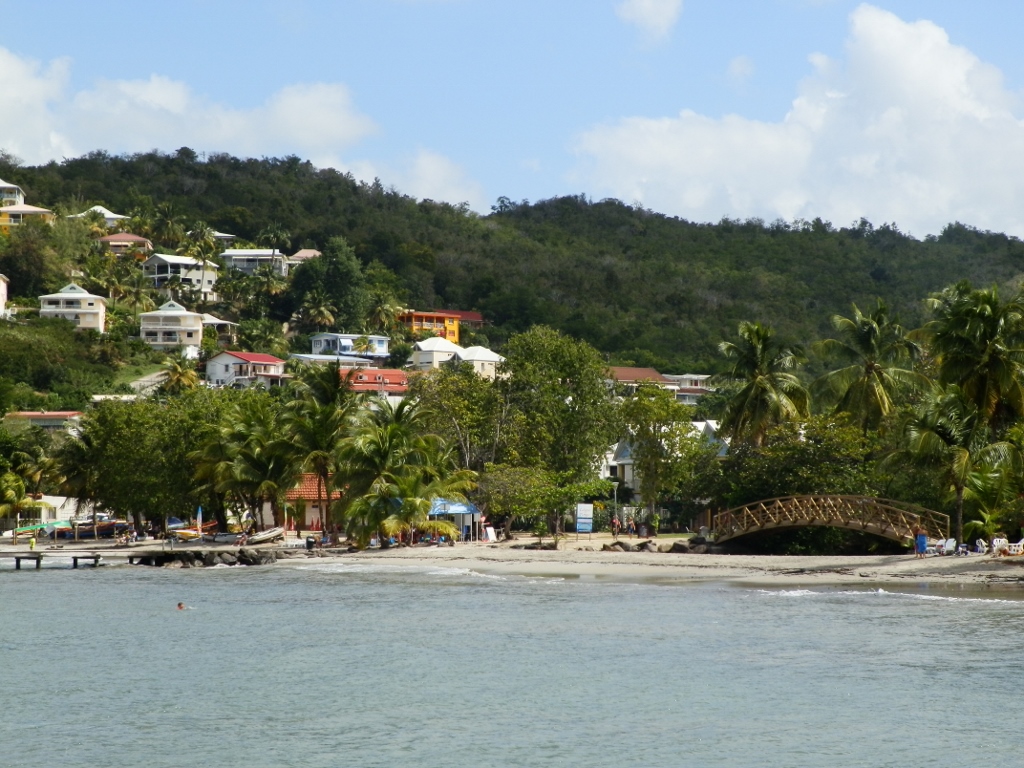 View from the boat at Anse a l’Âne
View from the boat at Anse a l’Âne
When the boat docked, I simply disembarked, but I also turned back in order to take a photo of it.
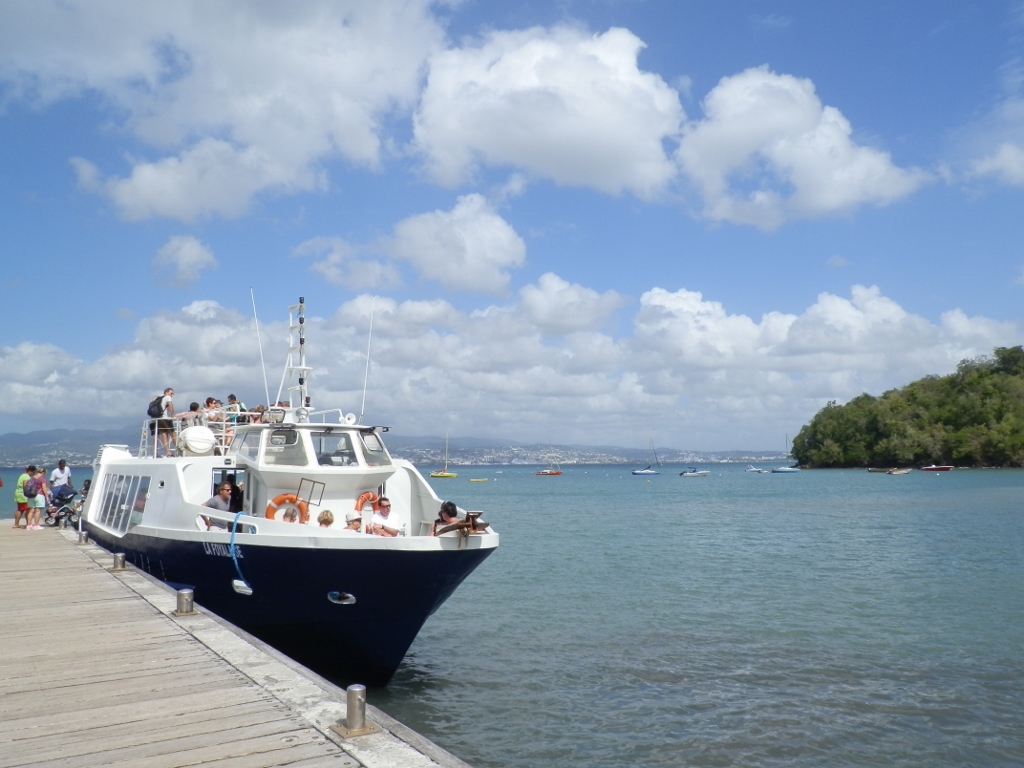 Boat-public transportation beside the boat-dock at Anse a l’Âne, with Fort-de-France in the distance
Boat-public transportation beside the boat-dock at Anse a l’Âne, with Fort-de-France in the distance
This day I was firmly set on having a swim, but I was not delighted with the beach. Still, I told myself I should relax and see how things develop during the day. While I was standing on the long boat-dock with the parked boat, I watched the beach of Anse à l’Âne thinking where it would suit me best to put down my own anchor. I opted for the middle section that is located between the public transportation boat-dock and a somewhat smaller dock used probably by local boats.
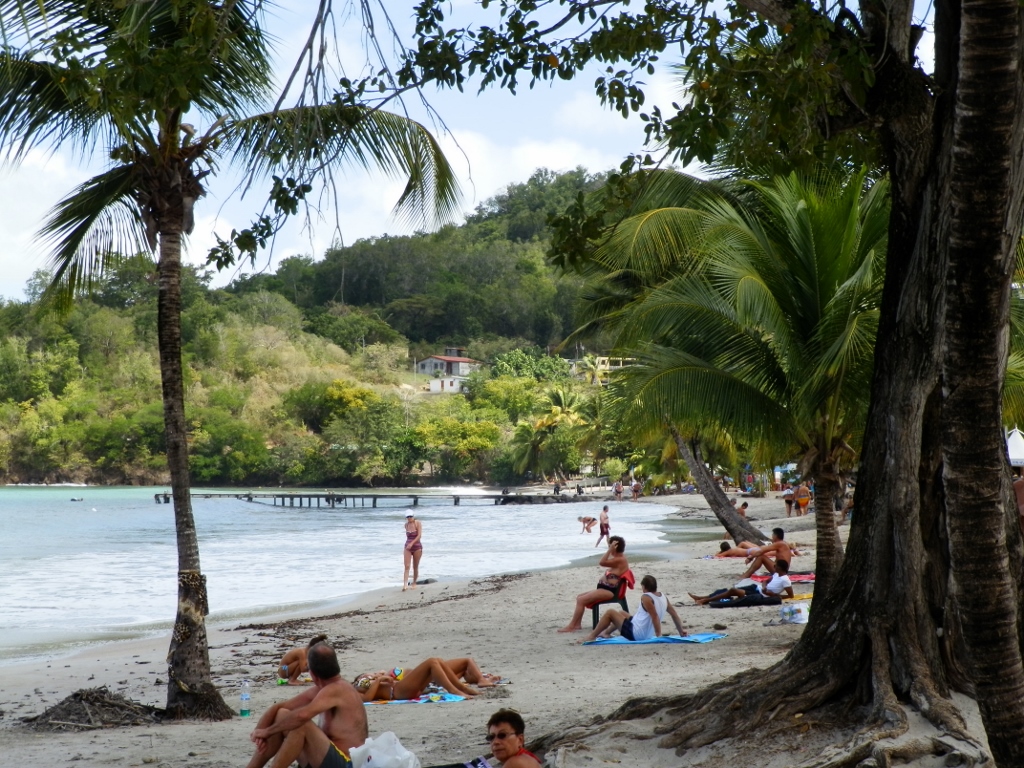 Anse a l’Âne beach
Anse a l’Âne beach
In fact, I decided to have a coffee break first and so sitting at a table of a beach restaurant I simply looked at my surroundings.
Afterwards, I went closer to the water, left my things beside a palm tree and entered the water in order to swim a little. The reason why I was not delighted was that the sand was greyish and such was the colour of the water as well, since the sand kept being lifted from the bottom, but the swim was a nice refreshment and it felt good.
When I got out, I just kept standing there on the beach in order to dry better and faster, and then I went for a walk from one side of the beach to the other sort of picking some shells washed ashore by the waves. Actually, I was just strolling in order to dry faster.
While I was idling on the beach, I saw a boat getting to the beach itself and then several young men pulled it over wooden logs across the beach and parked it there, after which several people approached the boat since this was the time to purchase fresh catch.
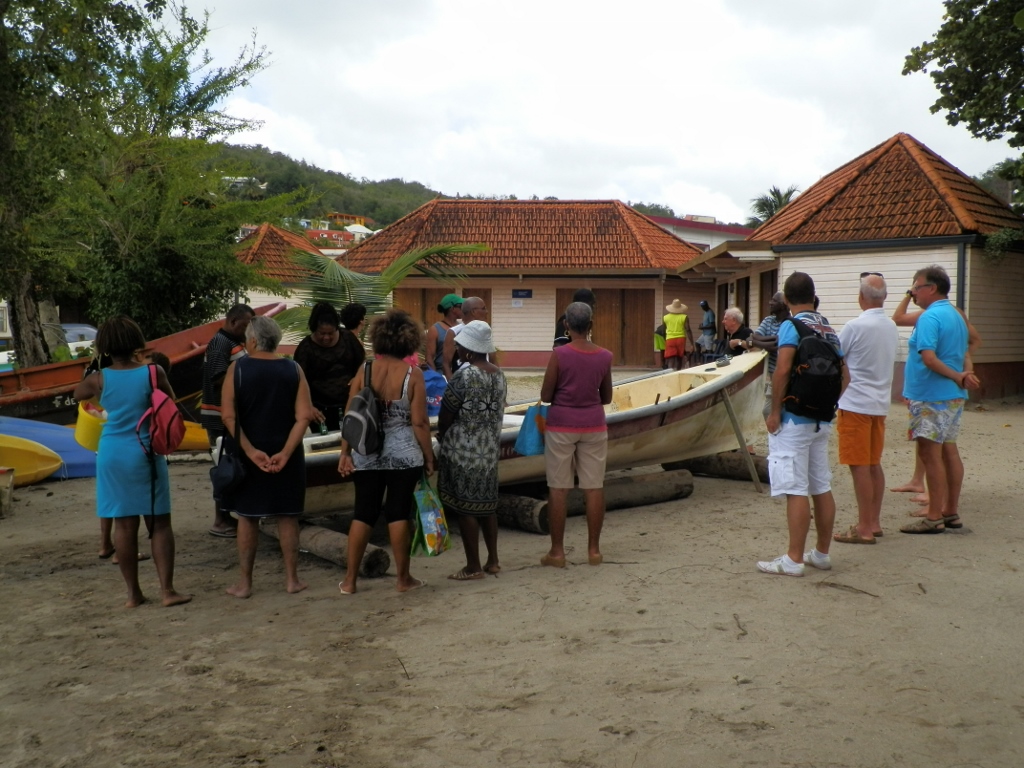 The “fish shop” has just arrived
The “fish shop” has just arrived
This day it was octopuses and fish up for sale. The interested buyers were local residents, as well as visitors who spend their time on Martinique by renting apartments and then they cater for themselves. I was just hanging around in order to take some photos, but then I was soon told that the fisherman in charge did not like this. Well, what can one do. At least I had taken a photo of the boat before the opening of the cool box.
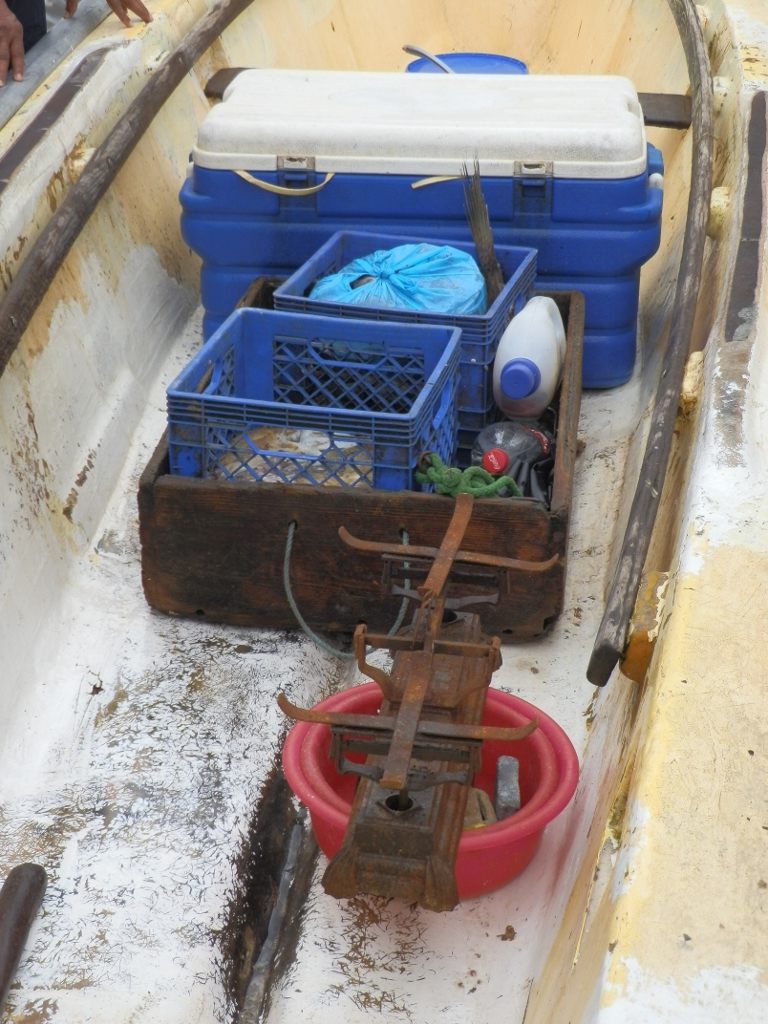 There are the scales, different accessories, as well as the cool box with fresh fish
There are the scales, different accessories, as well as the cool box with fresh fish
After a while I went for a swim again, but before getting fully soaked I actually took a photo in order to show how the water was indeed gray and murky, simply because the sand on the beach was gray and then the waves lifted up the sand which did not make a great impression. It was as if I were on some river beach and not in the tropics.
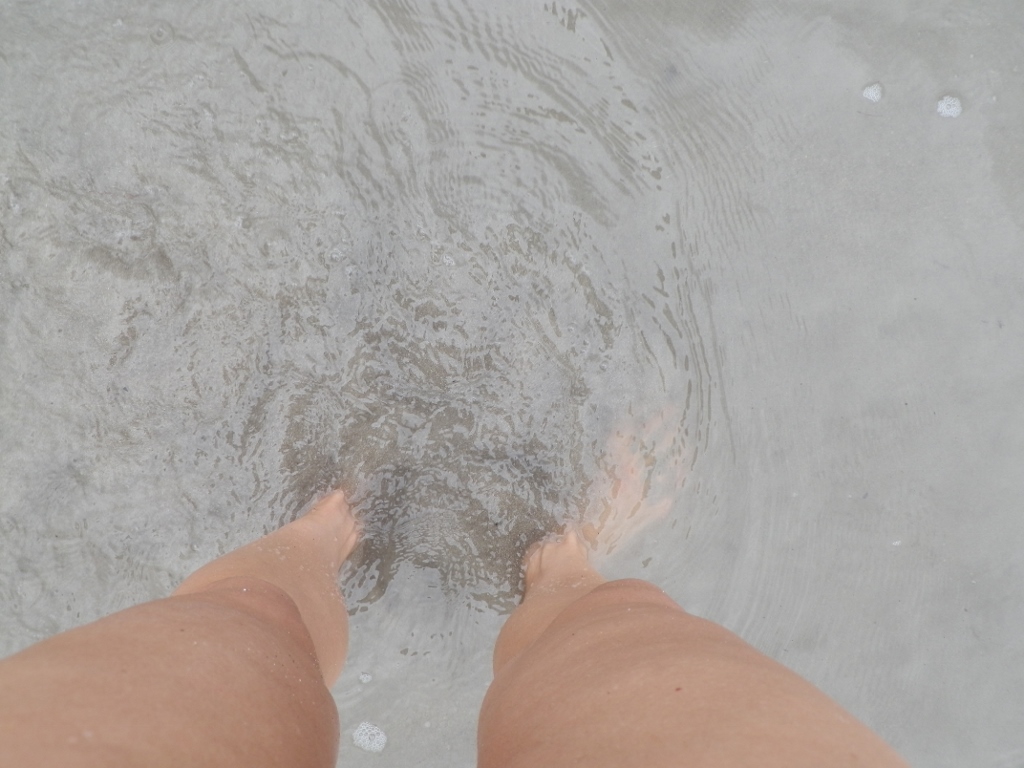 Water on the Anse a l’Âne beach
Water on the Anse a l’Âne beach
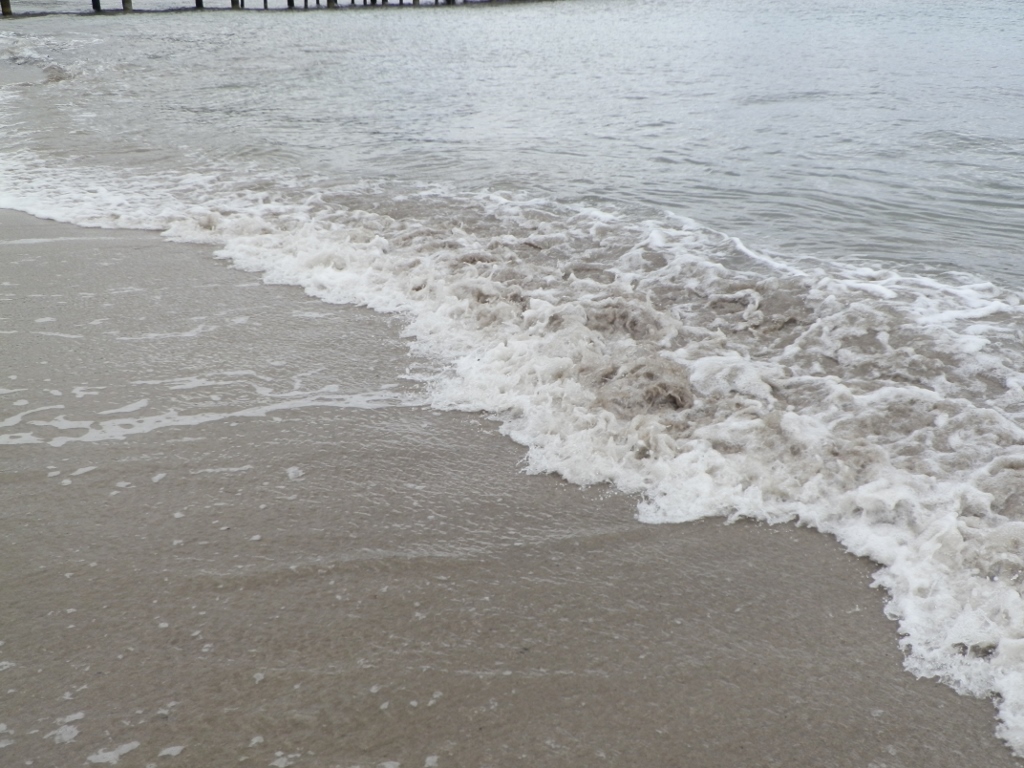 Water on the Anse a l’Âne beach
Water on the Anse a l’Âne beach
Meanwhile, it became cloudy, but it was still nicely warm.
Then it started to drizzle, but just barely, so I decided to move under a tree. However, by the time I had completed the mission, the rain had already stopped and I also realized that I was hungry, so I went again to the restaurant where I had had coffee this time in order to eat something. As far as the starter was concerned, it was easy – my absolute favourite during this journey were fish fritters (accras de morue).
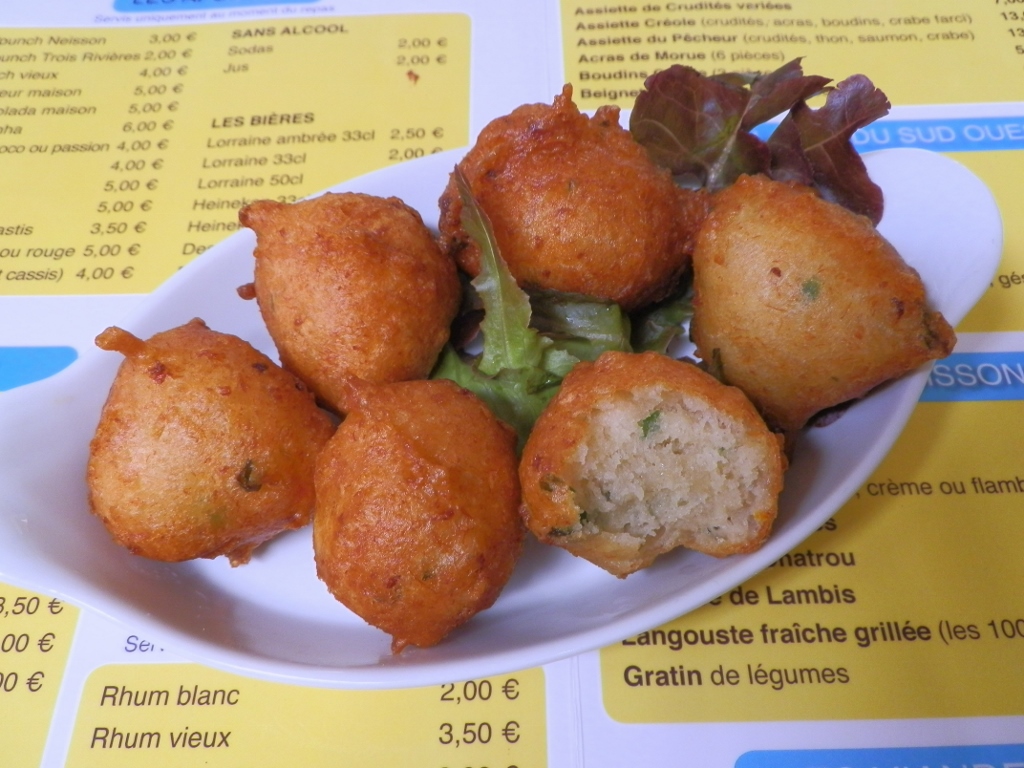 Fish fritters (Accras de morue)
Fish fritters (Accras de morue)
I think that this is a good point in time to give the recipe for my own version of this dish. The original is made of dry cod, but I must admit I’m too lazy to bother with the hydrating of cod, so I make my fish fritters using European hake. After all, it is related to cod, so I’m not way off base.
Accras de morue – my way
- 500 g piece of European hake (not fillets)
- 2 cloves of garlic
- 3 spring onions
- 1 handful of parsley
- 1 hot pepper
- salt and pepper
- 300 g all-purpose flour
- 260 ml water
- 10 g baking powder
- 1 tbsp of white rum (any spirit will do)
- juice of half a lemon
The hake is put in a pot and covered in water, while adding a little salt and the garlic that is just halved. The fish is cooked for some 20 minutes and then drained and left to cool. After that, it should be skinned and the bones should be removed. In fact, apart from the backbone, the European hake has no bones to speak of, so this is all very easy.
While the fish is cooking, put the spring onions, parsley and the hot pepper into a small food processor and mince them. Then take the vegetables out and when the fish has been prepared, put it (just the meat) into the food processor as well and mince it but very briefly, since it should not become a paté.
Then mix together in a bigger bowl the flour, water, salt (very little, since the fish is already salty) and ground pepper, as well as the baking powder. When this is mixed well, add the vegetables and the fish, and mix again. In the end, add the lemon juice and the white rum (the latter should prevent the fritters from absorbing too much oil during frying). The mixture should be left in a fridge for an hour.
Pour a lot of oil in a deep dish, heat it up and then using teaspoons put small pieces of mixture to fry. When the fritters get a nice colour, take them out with a slotted spoon and put them on paper towel in order to drain excess oil.
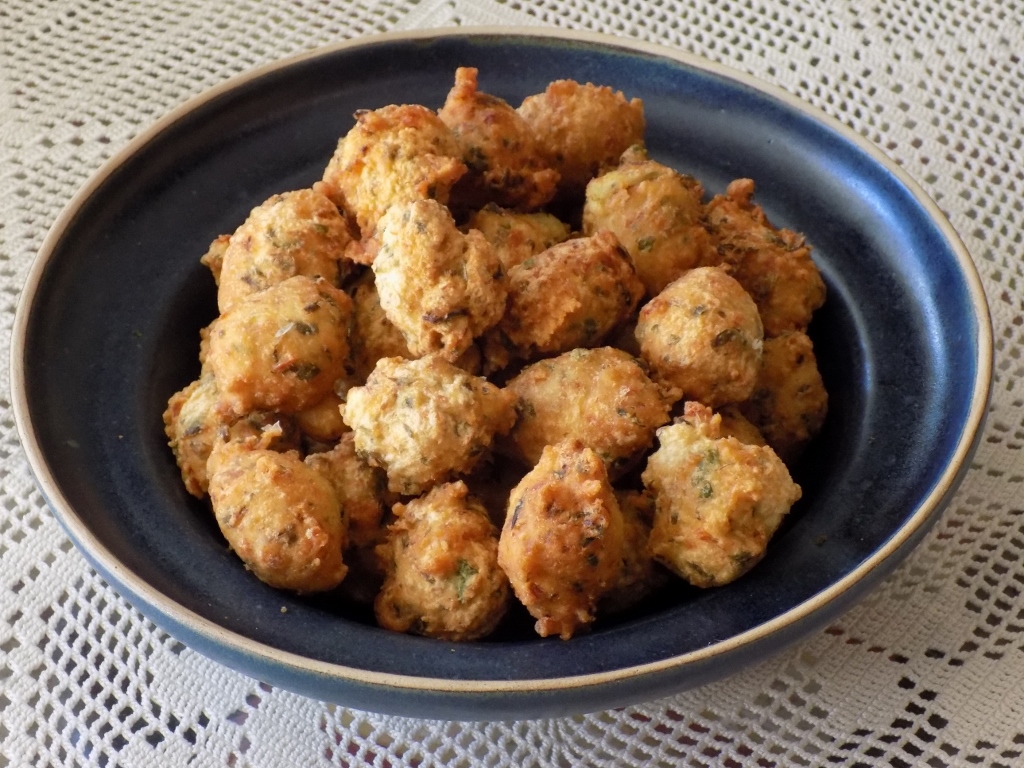 Fish fritters in my way: “Accras de merlu”
Fish fritters in my way: “Accras de merlu”
But, as far as the main course on the Anse a l’Âne beach is concerned, I took a dish with scallops which actually turned out to be the most expensive one on the menu and yet it was well within my daily budget, so I decided to give myself a treat. It was not spectacular, but it was not bad either.
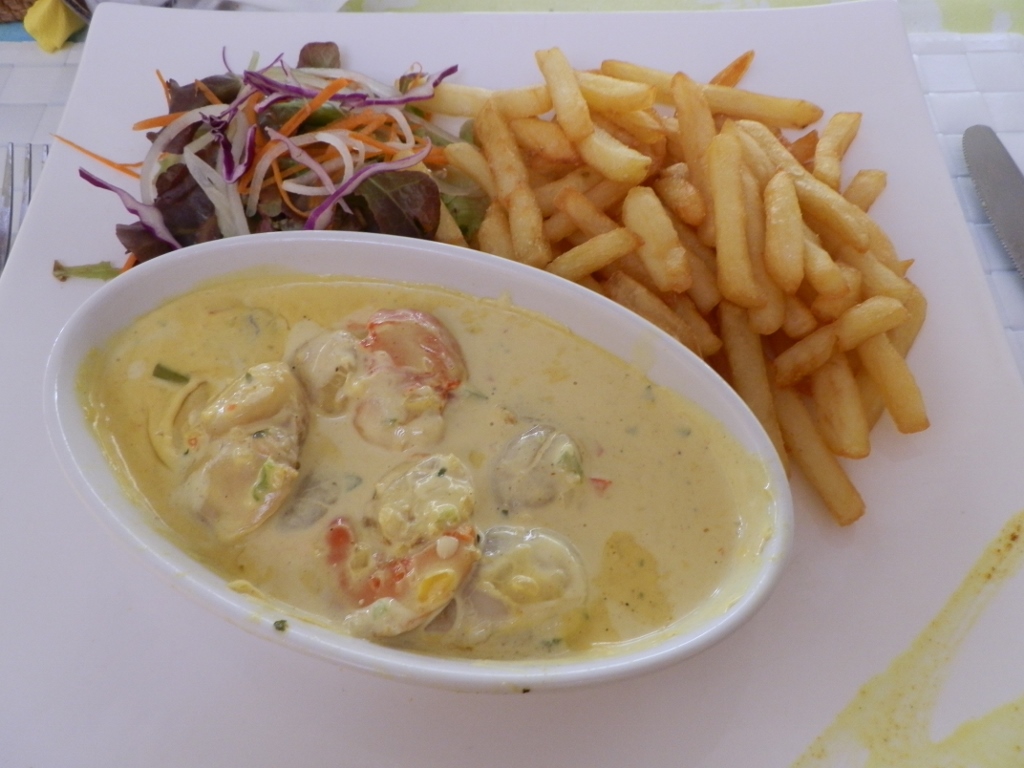 Main course with scallops
Main course with scallops
In the end, I felt like having a beer; I guess because of the warm weather.
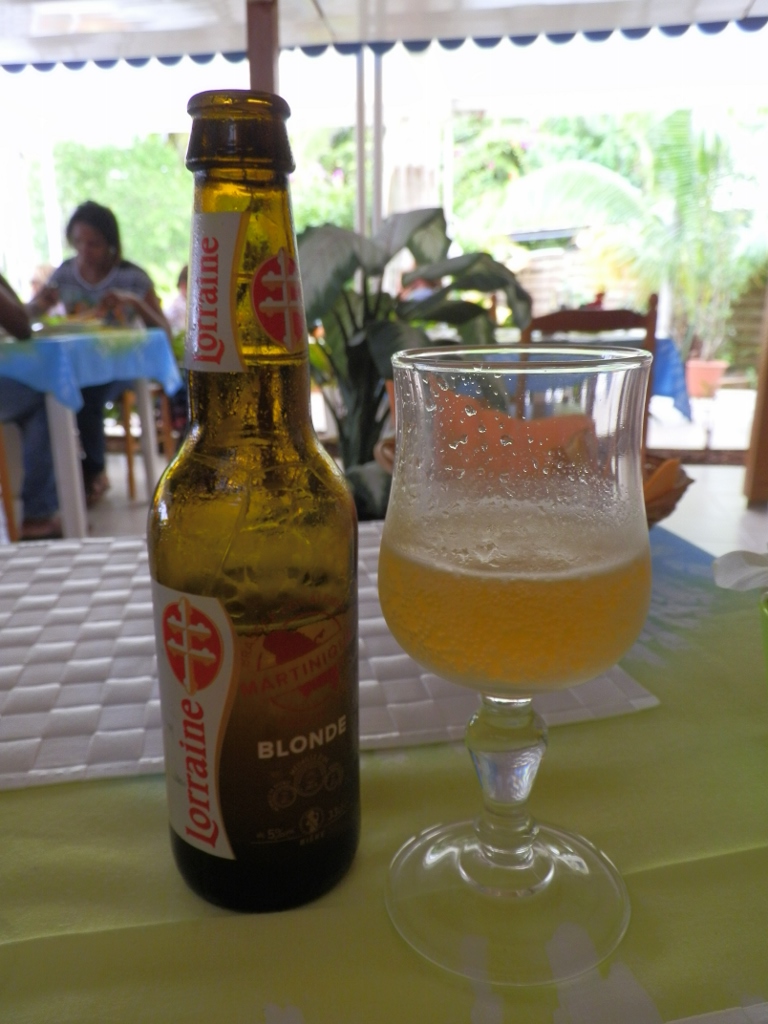 Local beer
Local beer
After the lunch I took my time sitting in the restaurant for quite a while and then I went for another walk to the end of the beach.
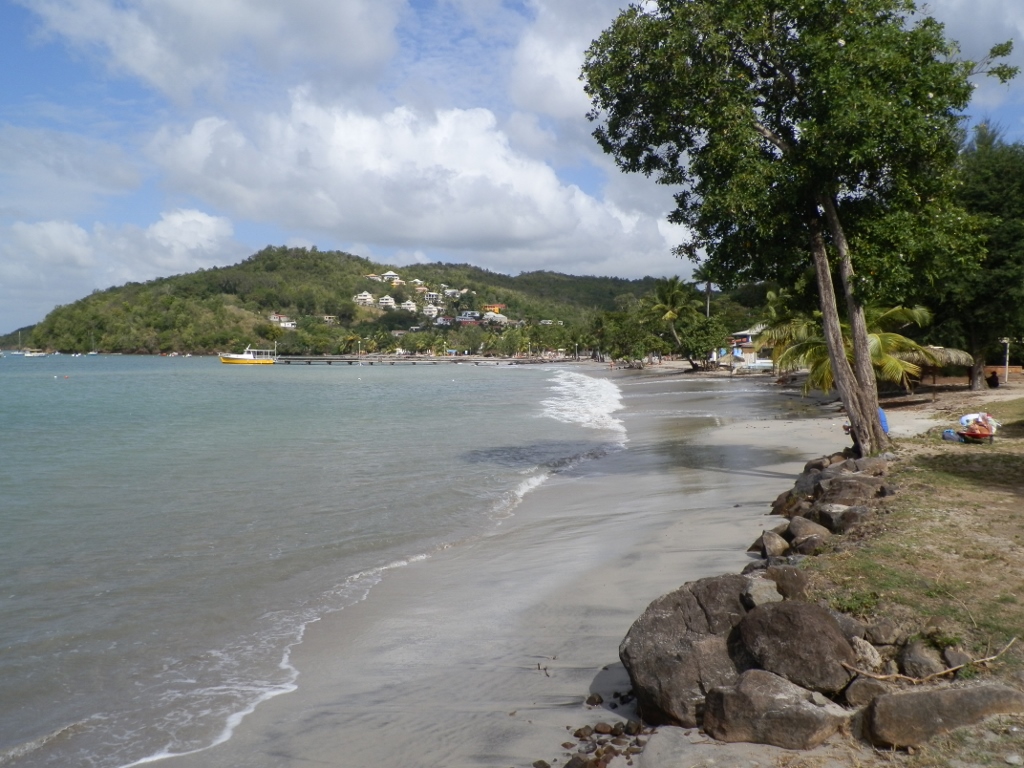 Anse a l’Âne beach
Anse a l’Âne beach
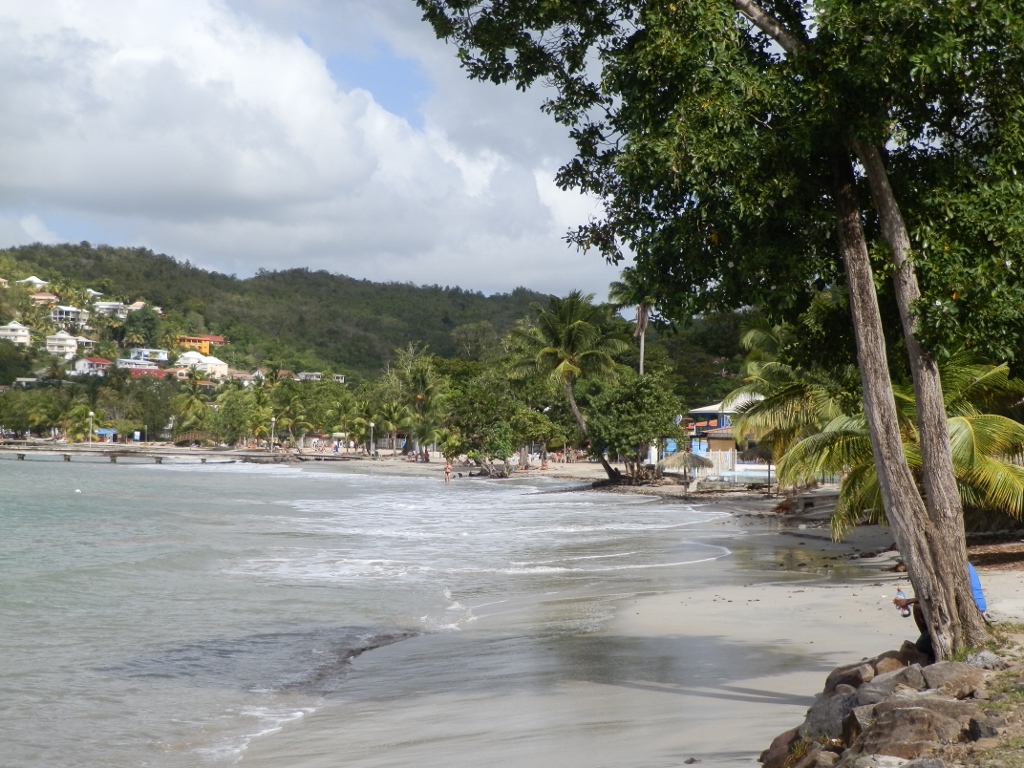 Anse a l’Âne beach
Anse a l’Âne beach
When I got to the end of the beach, I turned back watched the landscape in front of me and thought again that although seemingly everything appeared fine, moreover the photos look very nice and attractive, I minded the colour of the water that reminded me of mud. It was clear to me that this was sand and yet... I guess all the time I had this expectation of turquoise colour in my mind and for this reason I was unable to overcome the fact that I did not like the water visually. On the other hand, although there were not too many people on the beach, it was clear that there were certainly tourists/visitors who were probably staying in some of the numerous villas that are built at the slopes of the surrounding hillocks and then they get down to this beach. What I want to say is that this was not a beach from a deserted island, people do come here, they sunbathe and swim, and probably many are more realistic than me, with fewer expectations and therefore they can enjoy the experience more.
Be as it may, at some point I decided to move and leave Anse a l’Âne beach, so I started to hitch-hike. My idea was to return to the interior of the island, but as a matter of coincidence, a woman who picked me up was going to Anse Mitan. This is the cove in which the public boat stopped on its way from Fort-de-France.
Although by itself this beach was not even remotely as beautiful as the previous one, there were more people and too many sailing-boats, and there was also lack of greenery and shade, I actually significantly preferred the water, so I just left my things on the beach and went for a swim right away.
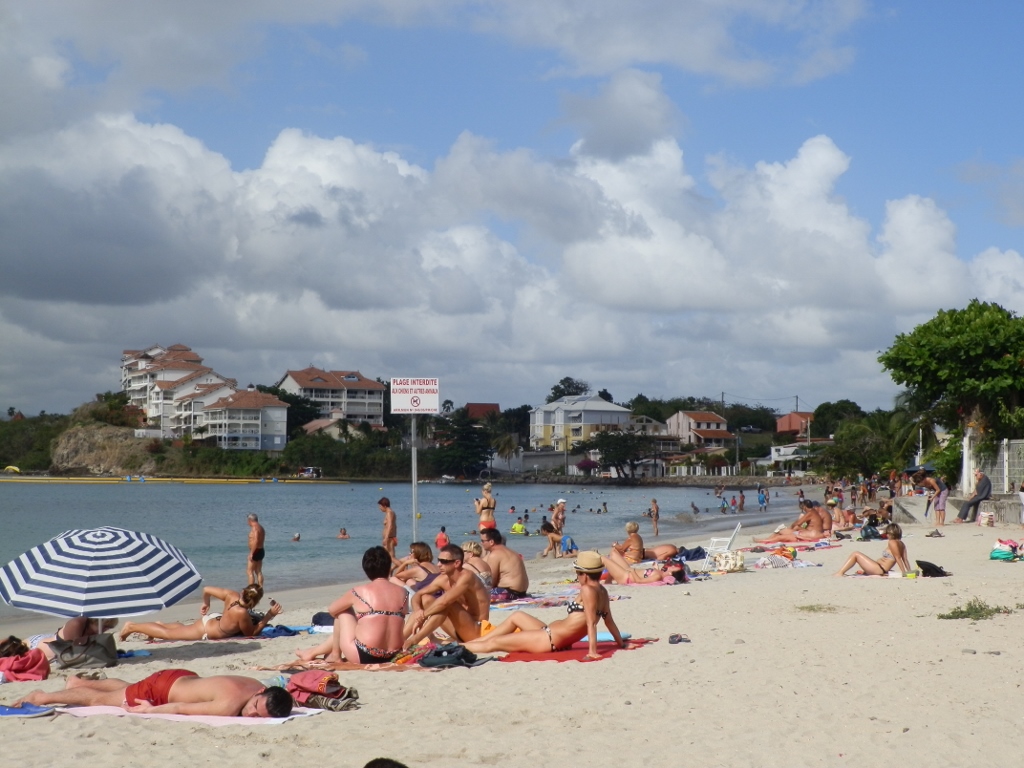 Anse Mitan beach
Anse Mitan beach
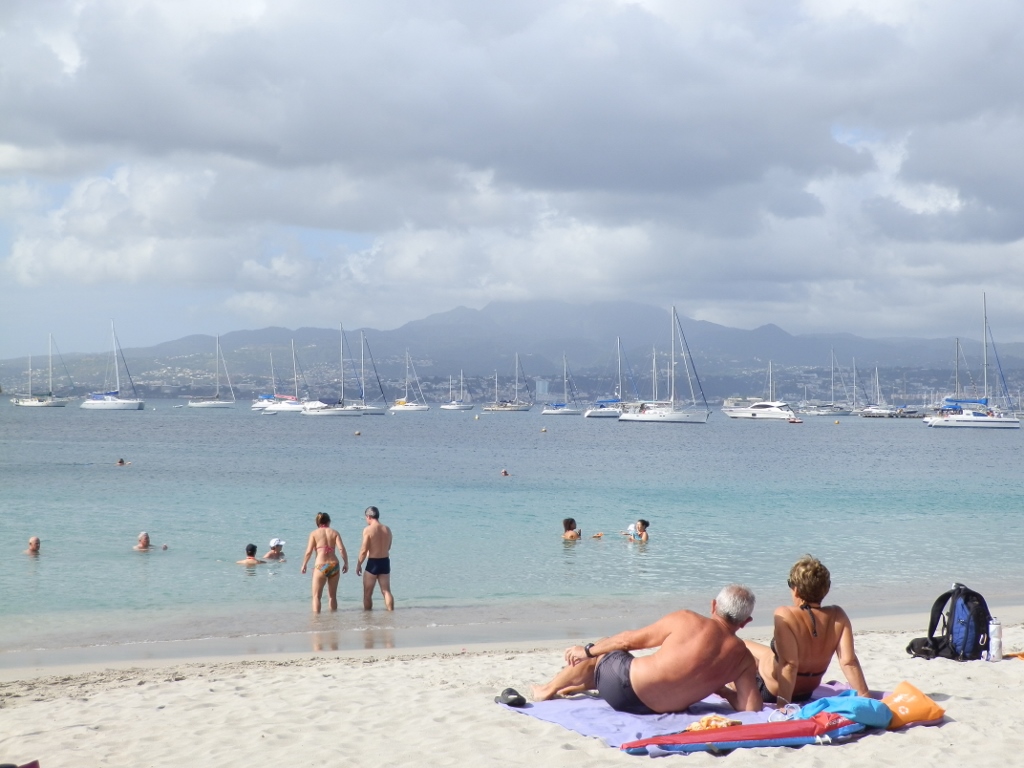 Anse Mitan beach
Anse Mitan beach
After a great swim which I thoroughly enjoyed I got out and waited there to get dry for quite some time. Namely, regardless of the temperature, because of the high air humidity, my swimsuit was taking time to get dry. Still, when I thought it was dry enough, I put the rest of my clothes on and then I started to walk to the nearby Pointe du Bout.
This entire horn, located opposite the capital Fort-de-France, is dedicated to tourism. There are numerous hotels, restaurants, tourist villas, shops, etc., and there is a marina as well. Practically, this was a large tourist settlement with all of the accompanying facilities. In comparison to the previous places I had visited, everything was crowded here and was not particularly attractive.
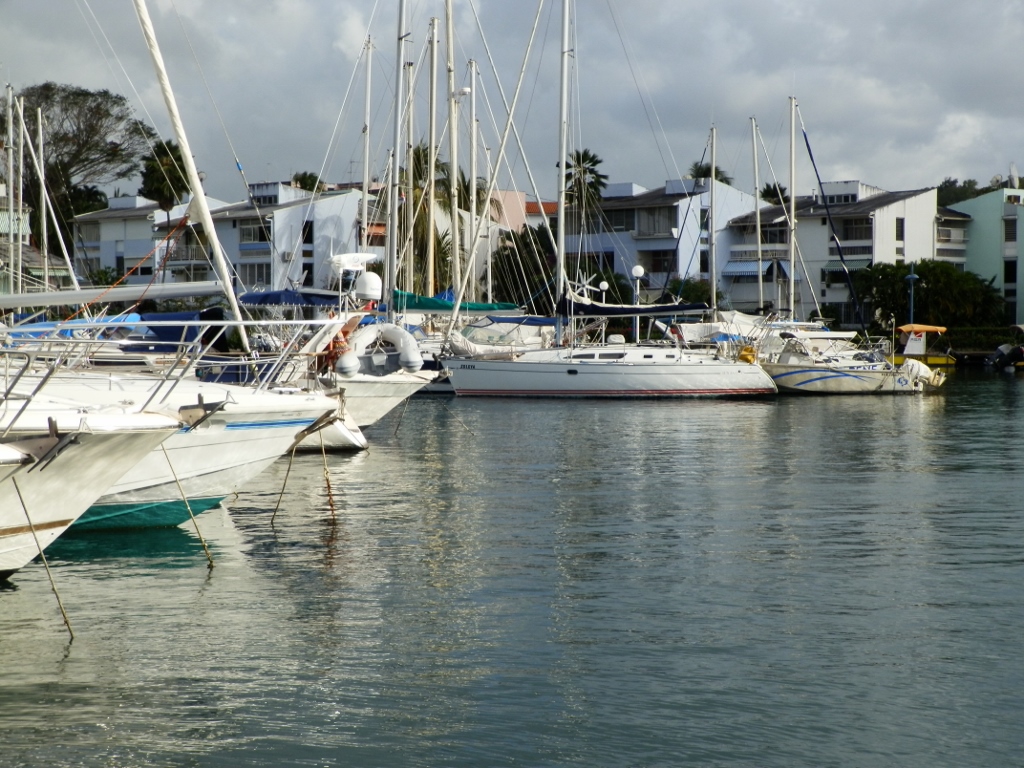 Pointe du Bout marina
Pointe du Bout marina
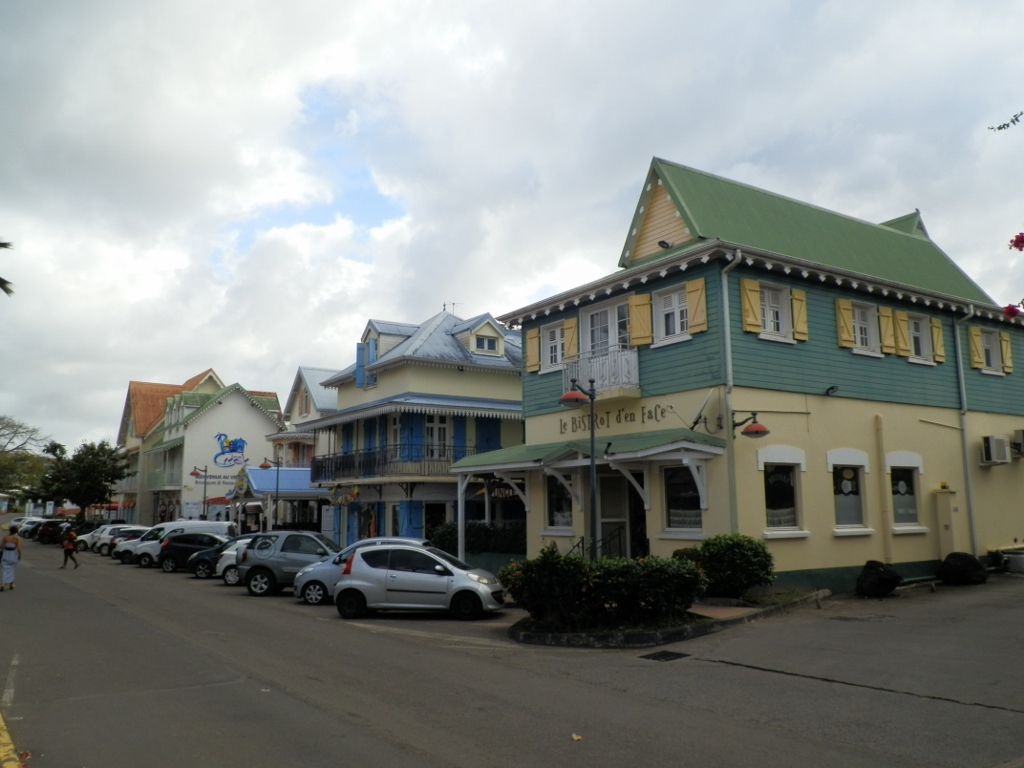 Detail from Pointe du Bout
Detail from Pointe du Bout
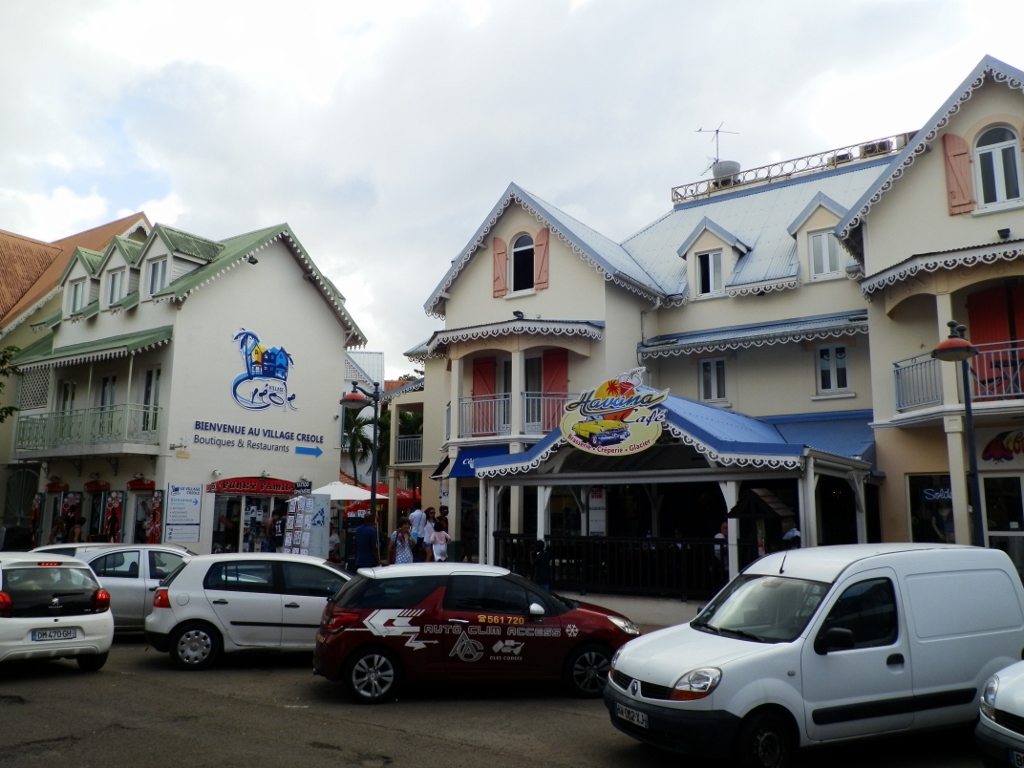 Detail from Pointe du Bout
Detail from Pointe du Bout
The walk around this urban area actually exhausted me, but then I was quite lucky and in two swift stages I hitch-hiked my way to the turning at the main road leading to Ducos. From here, I leisurely walked to the centre of the village and then also to the flat in which I had a rented room.
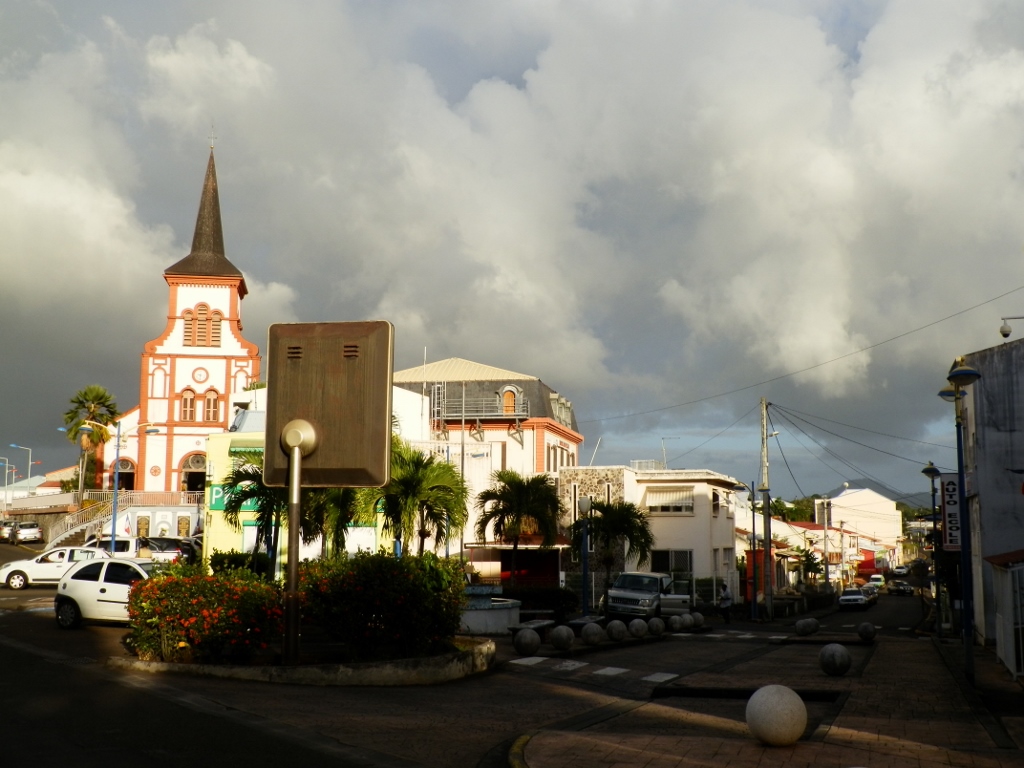 Centre of Ducos with the Church of the Birth of the Holy Virgin
Centre of Ducos with the Church of the Birth of the Holy Virgin
The next day, as usual I had my breakfast after the morning bathroom routine, then I chatted a little with Annie, my landlady, and then I started to wait for Cendrine. The agreement was that she should pick me up already at 8 am in order to go for yet another trip on Martinique, but in the meantime she called to say she would be a little late, so I just sat in the living room and started to wait.
Also, the night before I found an email from her in which she invited me for a barbecue on Monday. Namely, the people who lived in the same house on Martinique as Cendrine planned to have a barbecue party on that day and since I had already met some of them they invited me as well. For that day, which was to be my last day on Martinique, I had already planned to go and was actually looking forward to going again to Les Salines beach, since it was the only one that seemed worth the trouble, but I also thought it could be nice to accept the invitation. After all, I had already been on this beach and it could be nice to be in the company of other people.
But, on this day, when she came to pick me up we first went to Petit-Bourg where she lived, i.e., where she shared that house with other tenants. There Cendrine arranged with some girls some more details about the barbecue and its organisation and I also took the opportunity to give my share of the money for the meat and the rest of the things.
Then we went, this time only the two of us, to Habitacion Clement.
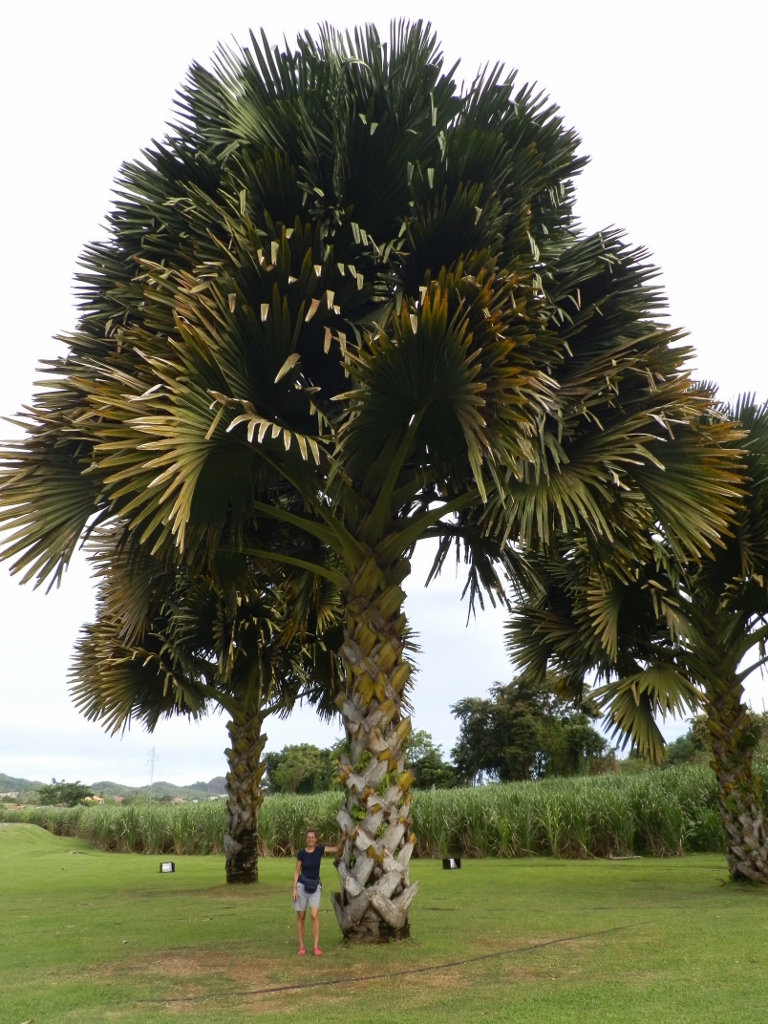 Next to a palm tree that grows in front of the entrance to Habitacion Clement
Next to a palm tree that grows in front of the entrance to Habitacion Clement
Habitacion Clement is the only plantation (habitacion) on Martinique that is fully open to public and it is also the only Creole household included in the list of historical monuments. The word “plantation” here includes the entire property and all the buildings (main house, kitchen and accommodation for workers, etc.), and there is also an old distillery, as well as new facilities, since this place manufactures rum, and there are also facilities where the rum should age, cellars, offices, etc. Namely, this plantation is considered the centre of the production of the so-called agricultural rum (rhum agricole), which is rum made solely of sugarcane juice. Since it is considered to be of better quality, this is also a more expensive rum in comparison to those kinds that are made of sugarcane molasses.
However, the main reason why Cendrine wanted to come specifically here, while I followed her in this venture, lies in the fact that Habitacion Clement also includes 17 hectares of lush botanical garden, which is actually a large park.
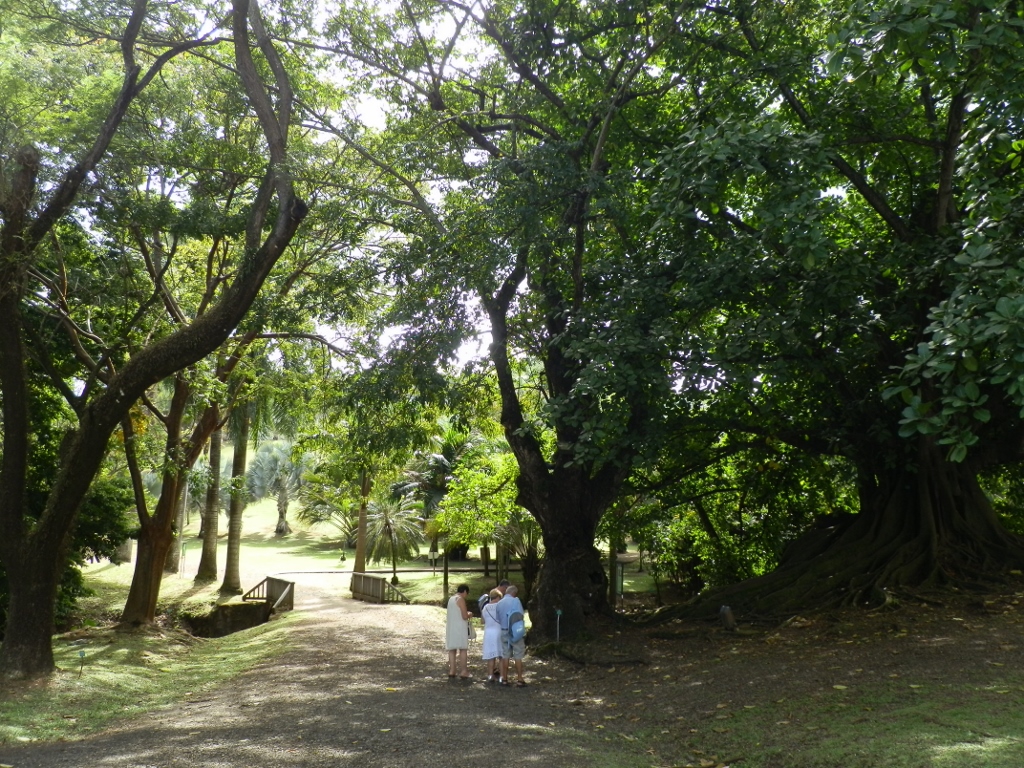 Entrance into the botanical garden section at Habitacion Clement
Entrance into the botanical garden section at Habitacion Clement
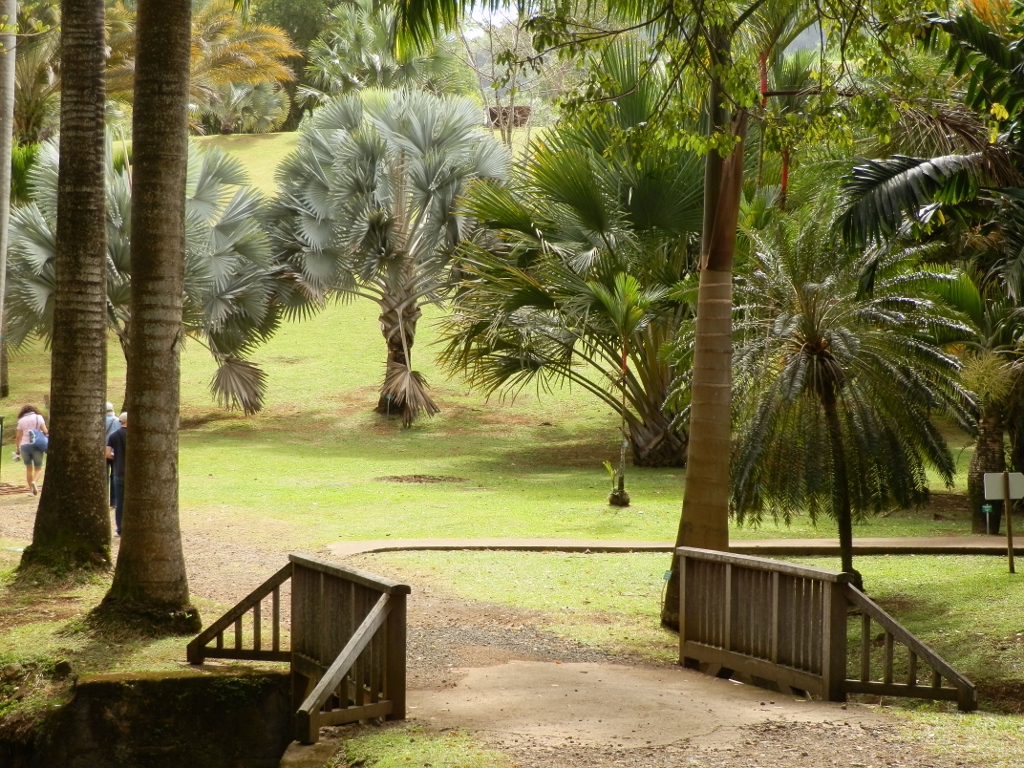 Entrance into the botanical garden section at Habitacion Clement
Entrance into the botanical garden section at Habitacion Clement
As Cendrine is a major fan of plants, then it was quite normal that she should like to come here. Therefore, I only accompanied her during this visit, but I did not regret it in the least. This was a very interesting visit to a large botanical garden. On the other hand, I am well known as a person who likes to take photos, but the level of detail which Cendrine took photos of on different plants surpasses everything I have ever done. I found it interesting to watch her paying attention to and taking photos of each minute detail of the plants and I thought that likewise people who travel with me also must have a lot of understanding and patience for my photographic proneness to details.
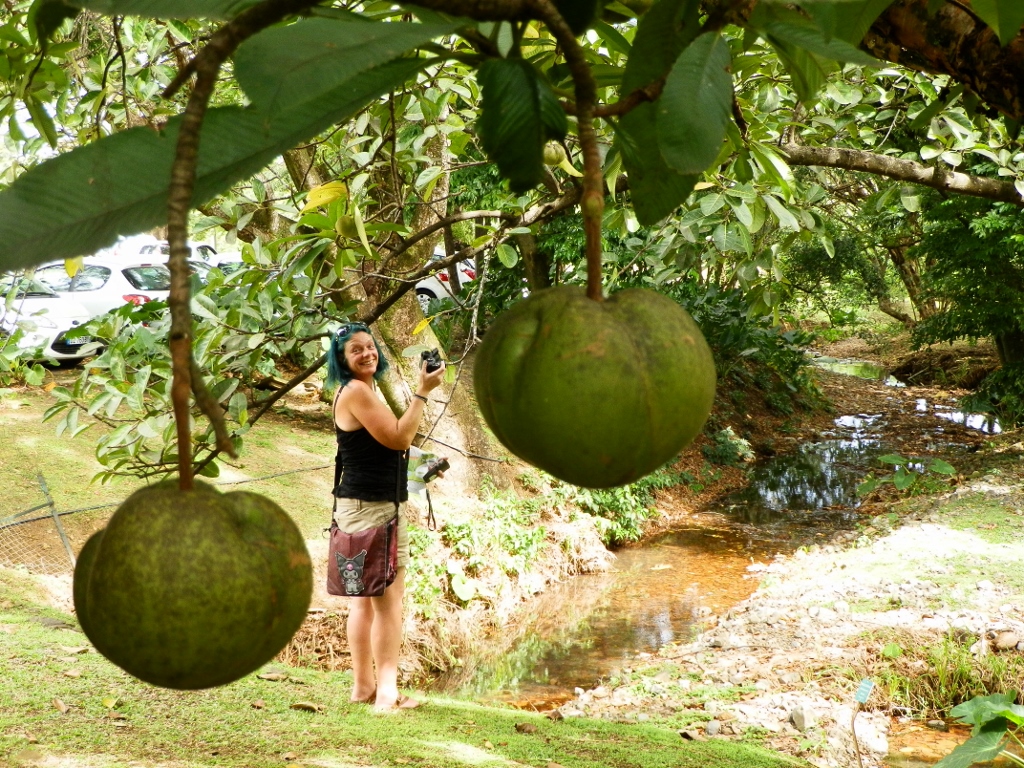 Exhilarated Cendrine
Exhilarated Cendrine
Even that above-posted photo of mine with the huge palm in front of the entrance to the plantation was taken because Cendrine stopped the car in order to be able to see the palms and take photos of them in peace. Although comparatively speaking I managed to understand a lot of what Cendrine was saying to me, it was really a pity that I didn’t speak more French, for it was obvious that I was here with a great connoisseur. It was precisely Cendrine who told me about the origin of the name of a palm tree from Madagascar that we saw here. This is the traveller’s palm (Ravenala madagascariensis), while the details in connection with it can be read in a sequel of my travel stories from Madagascar (https://www.svudapodji.com/en/madagascar-22/).
On the other hand, it helped me with the understanding of the names of different plants that there were small signs in the garden displaying name of the nearby plant/tree, including its Latin name. Thus I found out that the dense vegetation on the left-hand side of the photo below is in fact the elephant ear plant (Alocasia macrophylla).
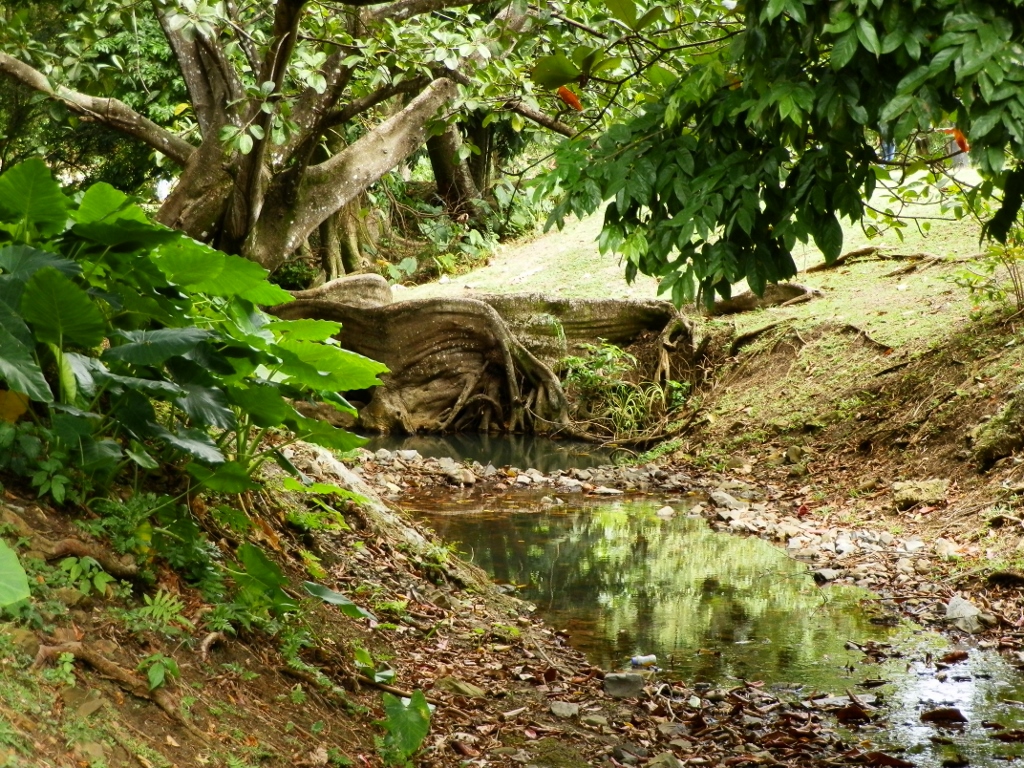 Detail from the botanical garden with the elephant ear plant
Detail from the botanical garden with the elephant ear plant
At the very entrance into the section with the botanical garden there was also a fantastic banyan tree (Ficus benghalensis).
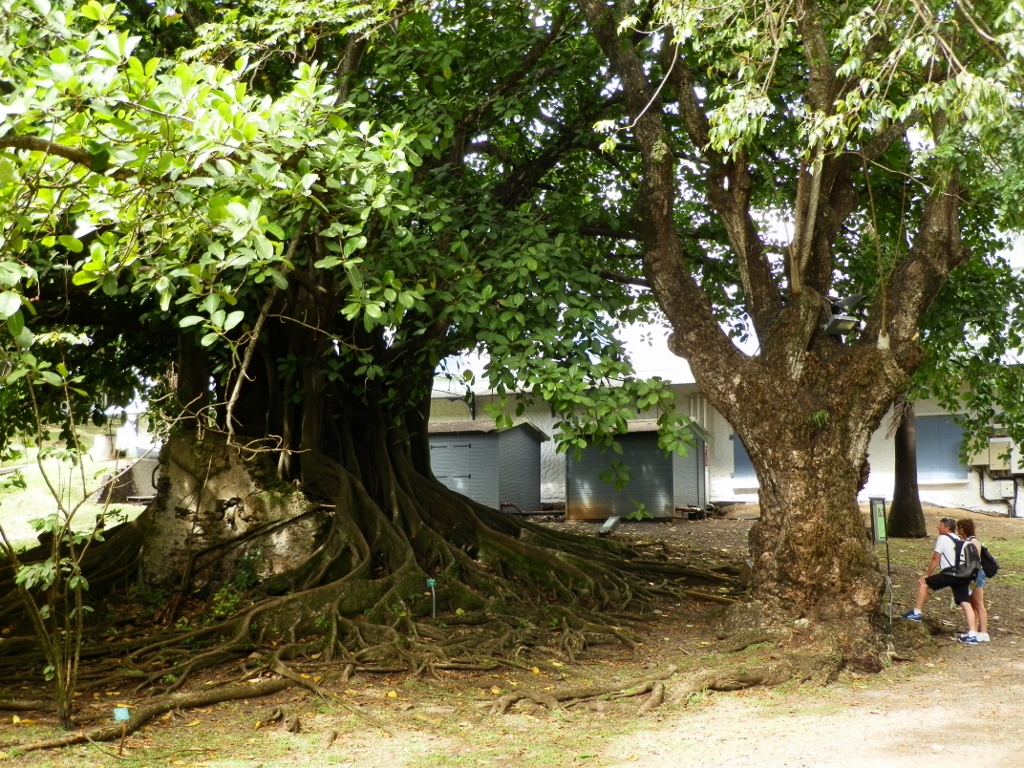 Banyan tree on the left-hand side of the photograph
Banyan tree on the left-hand side of the photograph
I have already written about this tree species in my stories about the journey across India in 2007 (https://www.svudapodji.com/en/india-16/), but I could mention now that this tree is relatively easy to recognise since its aerial roots hang down like hairs. When an aerial root comes across anything that can constitute some base for it, it holds on to it, let the roots into the ground, then cover the base, while the aerial root turns into a column, i.e., a trunk. Still, this tree is not considered a parasite since it does not feed on its “host.” It simply needs a lot of space and it snatches this space. What is additionally impressive with this tree are its buttress roots that can be clearly seen in the photo above.